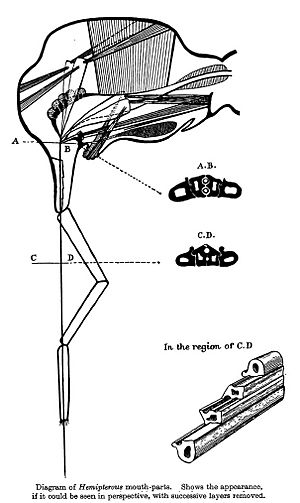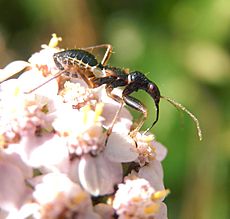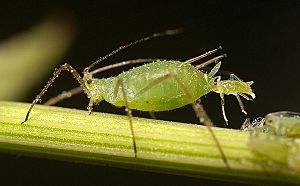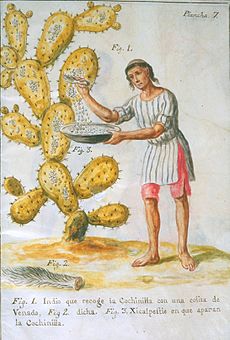Hemiptera facts for kids
Quick facts for kids Hemiptera |
|
|---|---|
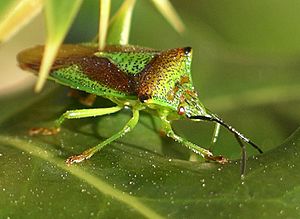 |
|
| Acanthosoma haemorrhoidale, a shield bug | |
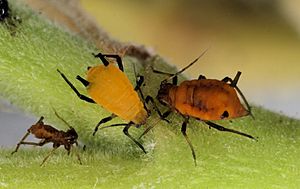 |
|
| Aphids | |
| Scientific classification | |
| Suborders | |
|

True bugs are a large group of insects. Scientists call them the Hemiptera. There are about 80,000 different kinds of true bugs. The word "bug" can mean other things too, but for scientists, it means these specific insects.
Contents
What's in a Name? The Hemiptera Story
The name "Hemiptera" comes from two Greek words: hemi (meaning half) and pteron (meaning wing). This name describes a special feature of most true bugs. Their front wings are half hard and half soft.
These special wings are called hemelytra. They look a bit like the hard wings (elytra) of beetles. The back wings of true bugs are completely soft. They are also shorter than the front wings.
Amazing True Bug Diversity
There are many different kinds of true bugs. Some common ones you might know are aphids, cicadas, planthoppers, and shield bugs. All of these are part of the true bug family.
True bugs come in many sizes. They can be as small as 1 mm (like the tip of a pencil) or as big as 10 cm (like a small hand). All true bugs have special mouthparts that they use to suck up plant sap.
| Paraneoptera |
|
||||||||||||||||||||||||||||||||||||||||||
| Group Name | Number of Species | First Seen | Examples | Special Features |
|---|---|---|---|---|
| Auchenorrhyncha | over 42,000 | Early Permian | cicadas, leafhoppers, treehoppers, planthoppers, froghoppers | They suck plant sap. Many can jump. Some make very loud calls. |
| Coleorrhyncha | fewer than 30 | Lower Jurassic | moss bugs | These bugs first appeared in an ancient southern continent called Gondwana. |
| Heteroptera | 25,000 | Triassic | shield bugs, seed bugs, assassin bugs, flower bugs, water bugs | These are often larger bugs. Many are predators, meaning they hunt other insects. |
| Sternorrhyncha | 12,500 | Late Permian | aphids, whiteflies, scale insects | They suck plant sap. Some are big pests for gardens and farms. Most do not move much or are completely still. |
Special Features of True Bugs
The most important feature of true bugs is their "beak." This beak has a sharp part called a stylet. The stylet can pierce into plant or animal tissues to suck out liquids. It has two channels: one for saliva to go out and one for liquid food to come in. When the bug is not using its beak, it usually folds it under its body.
Most true bugs eat plant sap. But some, like assassin bugs, suck blood. A few others are predators that eat other insects.
The front wings of true bugs can be either fully thin and clear, or partly hardened. Their antennae usually have four or five parts. Their legs have two or three segments at the very end, called tarsi.
True Bug Life Cycle
True bugs grow through a process called hemimetabolous development. This means they do not change completely from a larva to an adult, like butterflies do. Instead, their young are called nymphs. Nymphs look a lot like tiny adults.
Nymphs shed their skin several times as they grow. Each time they shed, they look more like the adult bug. Small wing buds appear on older nymphs. The final change is just the wings becoming fully grown (if the bug has wings) and the bug becoming able to reproduce. There is no pupa stage, like in butterflies or beetles.
How Aphids Reproduce
Many aphids can reproduce in a special way called parthenogenesis. This means the females can lay eggs that have not been fertilized by a male. These young are exact copies, or clones, of their mother. All these young are female, so every bug in the group can have babies.
Many aphids also give birth to live young instead of laying eggs. This is called viviparous reproduction. These special ways of reproducing help aphids make many babies very quickly when conditions are good.
True Bugs in Nature
Eating Plants
Most true bugs use their piercing mouthparts to feed on plant sap. This group includes cicadas, leafhoppers, treehoppers, planthoppers, froghoppers, aphids, and whiteflies. Some of them eat many different kinds of plants. Others move between different plants at different times of the year.
Plant sap is sugary but does not have many amino acids (building blocks for growth). So, these insects have to drink a lot of sap to get enough food to grow.
Working with Ants
Some ants protect and "farm" aphids and other sap-sucking true bugs. The ants collect and eat a sweet liquid called honeydew that the bugs secrete. This is a symbiotic relationship, meaning both the ants and the bugs benefit. The ants get food, and the bugs get protection from predators.
Some leafhoppers are also "milked" by ants in a similar way. In some rainforests, wasps also try to protect and milk leafhoppers. The leafhoppers sometimes give more honeydew to the wasps, perhaps because the larger wasps offer better protection.
Hunting Other Insects
Many other true bugs are predatory. This means they hunt and eat other insects, or even small vertebrates. For example, the predatory shield bug stabs caterpillars with its beak and sucks out their body fluids. The young of the Reduvius personatus, also called the masked hunter bug, covers itself with sand to hide. It can give a painful bite if it feels threatened.
Being Parasites
A few true bugs are parasitic. They feed on the blood of larger animals. These include bedbugs and the kissing bugs. Kissing bugs are part of the assassin bug family. They can spread a serious illness called Chagas disease.

Living in Water
Several true bug families live in water. These are called water bugs. Examples include water boatmen and water scorpions. Most water bugs are predators. Their legs are shaped like paddles to help them move through water.
The "pondskaters" or "water striders" are also linked to water. They use the surface tension of the water to stay on top. This group includes sea skaters, which are the only insects that truly live in the ocean.
True Bugs and Humans
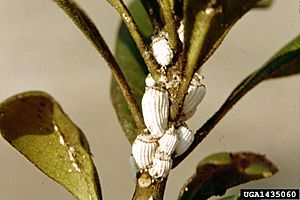
As Pests
Many true bugs are pests that harm crops and garden plants. This includes many kinds of aphids and scale insects. However, many other true bugs are harmless.
Some important pests are the cottony cushion scale, which harms citrus fruit trees. The green peach aphid and other aphids attack crops worldwide. They can also spread plant diseases. Jumping plant lice often only attack one type of plant and can spread diseases too.
Useful Insect Products
Some true bugs are helpful to humans. They are used to make dyes like cochineal and carmine. The scale insect Dactylopius coccus makes a bright red color to scare away predators. To make one kilogram (about 2.2 pounds) of cochineal dye, people need to collect and process up to 100,000 scale insects.
A similar number of lac bugs are needed to make one kilogram of shellac. Shellac is a colorant and wood finish. It is also used to wax citrus fruits to keep them fresh longer. It can also coat pills to protect them from moisture or hide bitter tastes.
Human Parasites and Disease Carriers
Chagas disease is a tropical illness caused by a tiny parasite. It is spread by kissing bugs. These bugs are called "kissing bugs" because they often bite humans around the lips while they sleep to suck blood.
The bed bug is a parasite that lives on humans. It usually lives in bedding and is active at night. It feeds on human blood, often without being noticed.
As Food
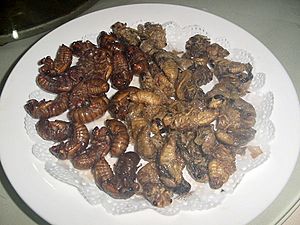
Some large cicadas are eaten as food in Asian countries like China. They are also popular in Malawi and other African countries. Insects have a lot of protein and are efficient to raise for food. However, most true bugs are too small to be a big part of the human diet.
In Art and Stories
Cicadas have appeared in stories since ancient times, like in Homer's Iliad. They have also been used as designs in art, like in ancient Chinese art from the Shang Dynasty. Aristotle and Pliny the Elder wrote about them. The ancient Greek poet Hesiod even described how cicadas make their loud songs.
In Myths and Folklore
Among all bugs, cicadas are special in myths and folklore around the world. They have been used as money, in traditional medicine, and to predict the weather. In China, they are even kept for their songs.
Images for kids
-
Leaf galls (growths) made by plant lice on a plant.
-
A twig wilting bug sucking sap from a Zinnia plant.
See also
 In Spanish: Hemípteros para niños
In Spanish: Hemípteros para niños





